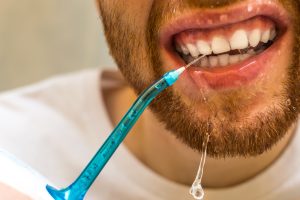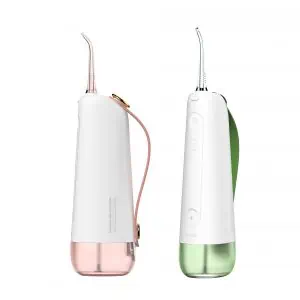If you have gum disease or receding gums, you may be looking for Waterpik solutions for periodontal disease. Waterpik is a brand of water flosser that is recommended for use especially when it comes to gum-related problems.
For gum disease and dental hygiene, the best Waterpik for gum disease should be part of your routine. You probably have heard that brushing is important, and most people do it regularly. But did you know that flossing and using a Waterpik could actually be more beneficial than brushing alone?
In this article, we’ll discuss the following:
- The best Waterpik for gum disease
- How the Waterpik perio tip works
- Waterpik Pik Pocket tip instructions
We hope that this information helps you choose the best Waterpik to tackle your periodontal problems for better overall oral health.
In This Article
What is a Waterpik?
Waterpik is a brand of water flosser, also known as an oral irrigator. This handheld device delivers a stream of water that cleans along your gumline and between your teeth. Much like flossing, it removes plaque, bacteria, and leftover food debris.
There are various models of water flossers, but the main difference is whether they are countertop or cordless models. Either way, they all have a reservoir that holds the water, a motor that powers the water stream, and a tapered nozzle to help aim the water exactly where it needs to go.
Waterpiks are especially beneficial to people who have a hard time combating bleeding gums, gingivitis, and periodontal disease. You can also use a water flosser for gum recession as it can reach up to 90% of your gum pocket, remove plaque and improve your gum health.
Many dentists recommend their patients add a water flosser to their oral hygiene routine — not to replace flossing, but to supplement it.
How to use a Waterpik

At first, getting used to a water flosser can be a bit tricky, and definitely messy. But here are some basic instructions to get you started:
- Fill the reservoir with room-temp water
- Make sure to close the reservoir cap securely
- Select the tip you want to use and insert it into the handle
- Place the tip in your mouth, aim it at the gum line, and lean over the sink
- Turn the water flosser on, keeping your mouth partly closed
- Move the water stream along your gumline, pausing in the spaces between teeth, and let the water flow out of your mouth into the sink
- Turn the device off while it’s still in your mouth
Don’t try to take the tip out of your mouth while the water flosser is still turned on — water will get everywhere, and honestly, if that concentrated stream of water hits you in the wrong place, it can hurt!
Also, did you know that it’s recommended to water floss before you brush? Read our guide to find out why.
Waterpik tip types
The following Waterpik tips are specific to the Waterpik brand, but most brands of water flossers will have a similar selection.
- Classic Tip: The classic tip is meant for everyday use and cleans between your teeth and below the gum line
- Ortho Tip: Use this tip if you have braces — it has a tapered end that is specially designed to remove plaque from braces
- Plaque Seeker Tip: This tip is especially good at removing plaque from the hardest-to-reach areas — it even has bristles that gently scrub to encourage plaque to get out
- Pik Pocket Tip: If you’re struggling with gum problems, this is the tip for you. It is designed to stream water or special antibacterial solutions deep into periodontal pockets
- Tongue Cleaner: This tip isn’t meant for your gums or your teeth — it has a special shape that removes bacteria from your tongue, for a cleaner tongue and fresher breath
- Toothbrush Tip: This isn’t an electric toothbrush tip — rather it’s a regular toothbrush that lets you brush your teeth while you water floss
- Implant/Denture Tip: This tip has a hooked design that provides optimal cleaning underneath the length of your dentures or implants

Best Waterpik for gum disease
Any Waterpik model can be used to help with gum disease, as long as you use the Pik Pocket tip mentioned above. One of the most popular Waterpik models is the Waterpik Ultra Professional water flosser.
This is a countertop model that comes with 7 different tips, including the Pik Pocket tip for periodontal pockets. It has a built-in timer and 10 pressure settings and is dishwasher safe so it’s easy to clean.
The Waterpik pocket tip is ideal for those struggling with gum problems as it enables you to direct the stream of water (or antibacterial solutions) directly into periodontal pockets. You can read more about this flosser in our Waterpik Ultra water flosser review.
Another water flosser that isn’t from the Waterpik brand, but that comes highly recommended, is the Oclean W10 water flosser. It is cordless and has a detachable reservoir that holds 200 mL of water, for up to 60 seconds of continuous flossing and has an impressive 30-day battery life.
It also has five modes — intensive, standard, pulsating, gentle, and on-demand, as well as a 15 seconds quad pacer and smart timer.
Most importantly for our purposes, it comes with four nozzles: Standard, Orthodontics, Tongue Scraping, and the Periodontal Pocket.
It also comes with a full 2-year warranty and 30-day money-back guarantee, meaning that if you aren’t satisfied within the first 30 days you can return it for your money back.
Gum stimulator vs Waterpik
A gum stimulator is not a water flosser. It’s actually a metal handle with a silicone or rubber tip attached to the end. You use it to massage your gum tissue and gently clean between your teeth since it has a tapered form and a pointed end.
They are also meant to increase the blood flow in your gums, letting more oxygen come into contact with your gum tissue and any infections. Oxygen can help treat gum disease in some cases, but the evidence is still coming out on that.
If you do struggle with periodontal disease or gum pockets, in general, it’s more likely that your dentist will recommend a Waterpik than a gum stimulator, but each case is different, so it’s definitely worth asking.
Conclusion

Waterpiks in general are beneficial for your gum health and can help in the treatment of periodontal disease. But, they also come with specific Waterpik periodontal tips — called the ‘Pik Pocket’ — which are meant to clean deep into gum pockets, removing bacteria and cleaning infected areas.
To supplement the Pik Pocket tip, you can also put hydrogen peroxide in a Waterpik (diluted) to further combat gum disease.
Waterpiks are not meant to replace brushing or flossing, but instead, are meant to supplement your oral hygiene routine. If you have problems with your gums, first of all, head to the dentist. And while you’re there, ask your dentist if you could benefit from a Waterpik for gum disease treatment.
FAQs
How do you use a Waterpik periodontal tip?
Without turning the water flosser on, set it to the lowest pressure setting. Then place the tip against a tooth at a 45-degree angle and slide it gently under your gumline and into the pocket. Then turn the power on.
What are the best Waterpik solutions for periodontal disease?
For periodontal disease, you may want to try the Waterpik Ultra Professional, which is their best-selling countertop model. It comes with a special periodontal pocket tip.
Why use a periodontal tip?
Not everyone needs to use a special periodontal pocket tip with their water flosser, but your dentist may recommend this if you have gum disease and gum pockets, for deep cleaning in the pockets.
What is the best Waterpik for periodontal disease?
The best Waterpik for periodontal disease is the Waterpik Ultra Professional with the Pik Pocket tip. You can also try another brand, Oclean, which also comes with a gum pocket tip.
Is Waterpik good for gums?
Waterpiks are good for removing food particles and bacteria from the teeth and gums and usually include a gentle setting, so they are often recommended for those struggling with gum disease.
NIH: Effects of the application of high-pressure oxygen on the treatment of periodontal disease in diabetic patients. Consulted 16th August 2022.





